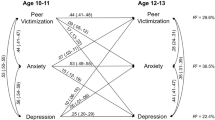Abstract
We examined the relation of overt and relational victimization to depressive symptoms, fear of negative evaluation (FNE), social avoidance, and loneliness in a sample of Hispanic and African-American children. The Social Experience Questionnaire, Children's Depression Inventory, Social Anxiety Scale for Children—Revised, and Asher Loneliness Scale were administered to 190 children in the fifth and sixth grades of an urban elementary school. Consistent with prior work, overt victimization was positively associated with depressive symptoms, FNE, social avoidance, and loneliness for both boys and girls. Relational victimization was found to be uniquely associated with depressive symptoms, FNE, and social avoidance of general situations for girls only. Prosocial behaviors from peers moderated the effects of relational victimization on loneliness, but no other social-psychological adjustment variables. Implications of our findings for the role of peer victimization and prosocial behaviors in the peer relationships of Hispanic and African-American children are discussed.
Similar content being viewed by others
References
American Psychological Association (1994). Publication manual of the American Psychological Association (4th ed.). Washington DC: American Psychological Association.
Asher, S. R., & Wheeler, V. A. (1985). Children's loneliness: A comparison of rejected and neglected peer status. Journal of Consulting and Clinical Psychology, 53, 500–505.
Asher, S. R., Hymel, S., & Renshaw, P. D. (1984). Loneliness in children. Child Development, 55, 1457–1464.
Bond, L., Carlin, J. B., Thomas, L., Rubin, K. and Patton G. (2001). Does bullying cause emotional problems? A prospective study of young teenagers. British Medical Journal, 323, 480–484.
Boulton, M. J., & Underwood, K. (1992). Bully/victim problems in middle-school children. British Journal of Educational Psychology, 62, 73–87.
Crick, N. R., & Bigbee, M. A. (1998). Relational and overt forms of peer victimization: A multi-informant approach. Journal of Consulting and Clinical Psychology, 66, 337–347.
Crick, N. R., Casas, J. F., & Ku, H. C. (1999). Relational and physical forms of peer victimization in preschool. Developmental Psychology, 35, 376–385.
Crick, N. R., & Grotpeter, J. K. (1996). Children's treatment by peers: Victims of relational and overt aggression. Development and Psychopathology, 8, 367–380.
Crouch, J. L., Hanson, R. F., Saunders, B. E., Kilpatrick, D. G., & Resnick, H. S. (2000). Income, race/ethnicity, and exposure to violence in youth: Results from the National Survey of Adolescents. Journal of Community Psychology, 28, 625–641.
Epkins, C. C. (2002). A comparison of two self-report measures of children's social anxiety in clinic and community samples. Journal of Clinical Child and Adolescent Psychology, 31, 69–79.
Hanish, L. D., & Guerra, N. G. (2000a). Predictors of peer victimization among urban youth. Social Development, 9, 521–543.
Hanish, L. D., & Guerra, N. G. (2000b). The roles of ethnicity and school context in predicting children's victimization by peers. American Journal of Community Psychology, 28, 201–223.
Hanish, L. D., & Guerra, N. G., (2002). A longitudinal analysis of patterns of adjustment following peer victimization. Development and Psychopathology, 14, 69–89.
Hawker, D. S., & Boulton, M. J. (2000). Twenty years' research on peer victimization and psychosocial adjustment: A meta-analytic review of cross-sectional studies. Journal of Child Psychology and Psychiatry, 41, 441–455.
Hodges, E. V., Boivin, M.Vitaro, F., & Bukowski, W. M. (1999). The power of friendship: Protection against an escalating cycle of peer victimization. Developmental Psychology, 35, 94–101.
Huesmann, L. R., & Guerra, N. G. (1997). Children's normative beliefs about aggression and aggressive behavior. Journal of Personality and Social Psychology, 72, 408–419.
Judd, C. M., & McClelland, G. H. (1989). Data analysis: A model-comparison approach. New York: Harcourt Brace Jovanovich Publishers.
Kovacs, M. (1992). The Children's Depression Inventory. Manual. Toronto, Canada: Multi-Health Systems, Inc.
LaGreca, A. M., & Stone, W. L. (1993). Social Anxiety Scale for Children—Revised: Factor structure and concurrent validity. Journal of Clinical Child Psychology, 22, 17–27.
Menacker, J., Weldon, W., & Hurwitz, E. (1990). Community influences on school crime and violence. Urban Education, 25, 68–80.
Moran, S., Smith, P. K., Thompson, D., & Whitney, I. (1993). Ethnic differences in experiences of bullying: Asian and White children. British Journal of Educational Psychology, 63, 431–440.
Morris, T. L., Messer, S. C., & Gross, A. M. (1995). Enhancement of the social interaction and status of neglected children: A peer-pairing approach. Journal of Clinical Child Psychology, 24, 11–20.
Nansel, T. R., Overpeck, M., Pilla, R. S., Ruan, W. J., Simons-Morton, B., & Scheidt, P. (2001). Bullying behaviors among US youth: Prevalence and association with psychosocial adjustment. Journal of the American Medical Association, 285, 2094–2100.
New York City Department of Education (2001). Facts and Figures 2001–2002: Answers to frequently asked questions about English language learners and bilingual programs. New York: New York City Department of Education.
Paquette, J. A., & Underwood, M. K. (1999). Gender differences in young adolescents experience of peer victimization: Social and physical aggression. Merrill-Palmer Quarterly, 45, 242–266.
Prinstein, M. J., Boergers, J., & Vernberg, E. M. (2001) Overt and relational aggression in adolescents: Social-psychological adjustment of aggressors and victims. Journal of Clinical Child Psychology, 30, 479–491.
Siann, G., Callaghan, M., Glissov, P., Lockhart, R., & Rawson, L. (1994). Who gets bullied? The effect of school, gender, and ethnic group. Educational Research, 36, 123–134.
Storch, E. A. (2002). Prescriptions of medications to youths. Psychiatric Services, 53, 214–215.
Storch, E. A., & Masia, C. L. (November, 2001). Peer victimization and social anxiety and distress in adolescence. In M. Prinstein (Chair), Peer relationships, social anxiety, and developmental psychopathology. Symposium presented at the annual meeting of the Association for the Advancement of Behavioral Therapy, Philadelphia, PA.
Stueve, A., O'Donnell, L., & Link, B. (2001). Gender differences in risk factors for violent behavior among economically disadvantaged African-American and Hispanic young adolescents. International Journal of Law and Psychiatry, 24, 539–557.
Author information
Authors and Affiliations
Rights and permissions
About this article
Cite this article
Storch, E.A., Nock, M.K., Masia-Warner, C. et al. Peer Victimization and Social-Psychological Adjustment in Hispanic and African-American Children. Journal of Child and Family Studies 12, 439–452 (2003). https://doi.org/10.1023/A:1026016124091
Issue Date:
DOI: https://doi.org/10.1023/A:1026016124091




